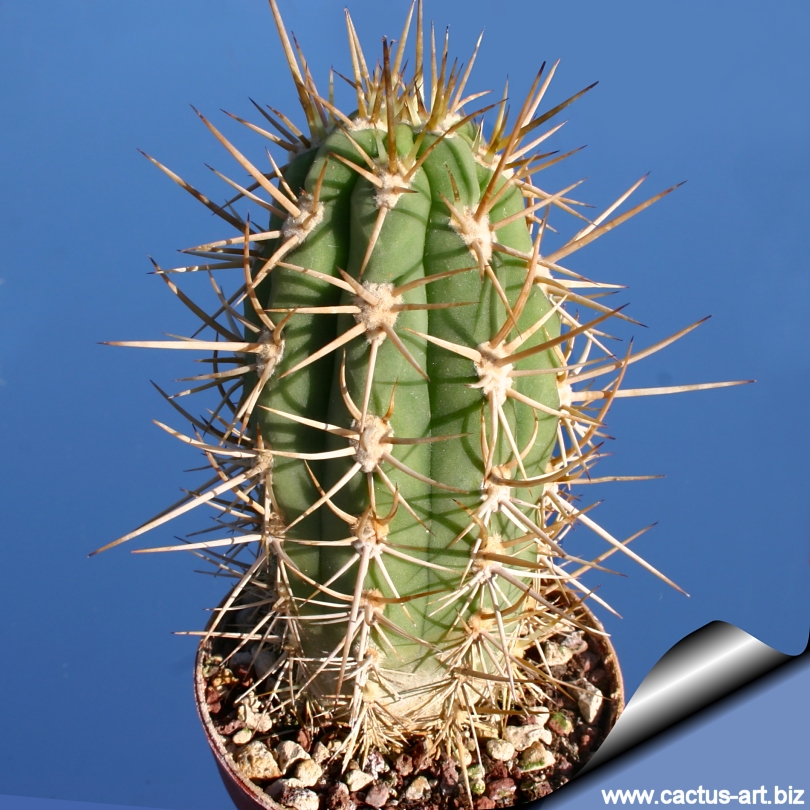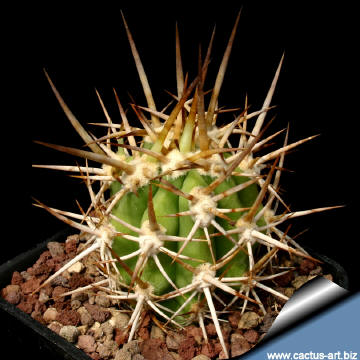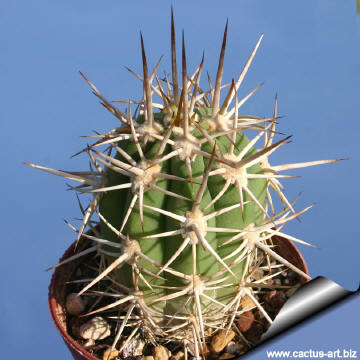|
|
|

Trichocereus chiloensis var.
borealis is a fiercely spiny
cactus. In habitat it can produce very long spines, up to 25 cm
long, but usually shorter in cultivated specimens.
|
 |
 |
|


Advertising
|
|
|
|
|
Family:
Cactaceae (Cactus
Family)
Trichocereus chiloensis v. borealis F. Ritter
Published in: Kakteen in Südamerika, 3: 1109, 1980
Scientific name: Trichocereus chiloensis (Colla) Britton
& Rose
Published in: The Cactaceae; descriptions and
illustrations of plants of the cactus family 2: 137-139, f. 199-200,
1920
Origin: Chile. Description:
T. chiloensis borealis is a fiercely spiny
cactus. It
develops into a
shrub or small
tree. Rarely
single, usually of several
branches, sometimes of many, arising from near the
base, starting nearly at right angles to the main
trunk but soon erect.
Stem:, Stout, cylindrical up to 8 m tall, stems 10-12.5 cm in
diameter
Ribs: 10 to 17 low and broad
ribs, separated by narrow intervals, divided into large
tubercles even when fully
mature.
Areoles: Areoles large whitish, 2 cm apart.
Spines:
Creamy-white to yellowish with brown tips, at least when young, greyish
later;
Central spines:
Usually 1 (or sometime up to 4) stout, 5-10 cm (or even 25 cm) long
Radial spines: 8
to 12 1-2 cm long (occasionally up to 5 cm).
Flowers: Flower
Nocturnal (opening at the end of the day) 14 cm. long, outer
perianth-segments
white but tinged with red or brown; inner perianth-segments white,
acuminate.
Fruit: Globose green.
|
|
|
|
Cultivation:
It is very easy to grow and cold hardy as low as -12°C (or less). Need a
fertile, well drained soil mix. Water the plants well and allow them to
dry before watering again. This species seems to do better with a little
more water than most cacti. In fact, its cultivation requirements are
really more like 'normal' plants than most other cacti. During the
growing season fertilize them monthly with a balanced fertilizer
Sun Exposure: Outside
full sun, inside needs bright light, and some direct sun. During
winter month, put them in a cool luminous place and encourage them to
enter winter dormancy by withholding water and fertiliser over the
winter as they will etiolate, or become thin, due to lower levels of
light. They are susceptible to fungal diseases if overwatered, but are
not nearly as sensitive as many other cacti, especially in warm weather.
They tend characteristically towards black rotted spots unless watering
is moderate and only in hot weather, if kept damp through cold periods,
they will invariably suffer.
T. chiloensis produces noticeable amounts of growth each year if
kept well fed and watered throughout the warmest months, particularly if
it has been acclimatised to accept full sun. Once this cactus is
established it can easily produce 20cm of growth every year.
Propagation: Cutting or
from seed. The seeds are quite easy to germinate and grow. Their main
requirements consist of high humidity levels, free-draining soil mix,
and enough water, light, and nutrition
|
|
Photo of conspecific taxa, varieties, forms and
cultivars of Lobivia (Echinopsis) pentlandii .
Of plants belonging to the Lobivia...
complex
(This
Taxon
has lots of synonyms
(like most Lobivia) whit several controversial varieties and subspecies):
|
|